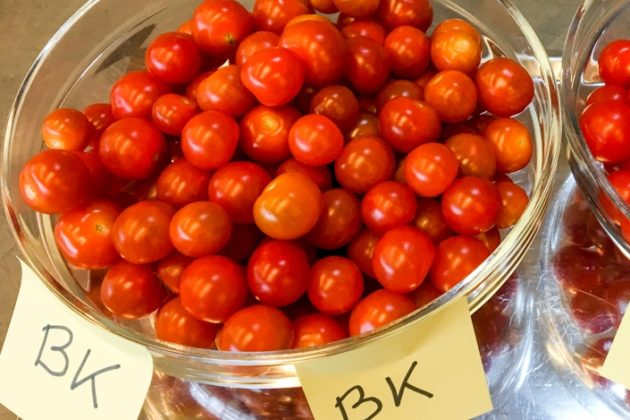Dark red cherry tomatoes, please!

What role does the colour of the food play in canteen guests’ choice of what to eat? We have tested people’s response to a range of different coloured cherry tomatoes and how different shades of red are perceived.
The way we perceive the food in front of us affects our food choices to a certain extent. This applies to both the food item itself, but also how it is presented — for example, dish colour and how it is served. As part of the research project Biofresh, we are investigating how to increase consumption of greenhouse vegetables in cafeterias. In this project, we collaborated with ISS Facility Services, and performed our tests at their canteens. In this trial, we focused on the colour of cherry tomatoes.
Tasting changed the perception of the colour red
In order to test how people rated the ripeness of the tomatoes, we conducted tests at a school canteen and a company canteen. We placed two bowls of cherry tomatoes next to each other – one contained light-coloured, pale tomatoes, and the other dark red tomatoes. Both bowls contained the same type of tomato. We then asked the canteen guests to complete a questionnaire before and after they tasted the tomatoes. Before tasting, most judged the pale tomatoes to be less ripe than the dark ones and thought they would prefer the darker tomatoes. After tasting, a massive 47% changed their opinion and gave the pale tomatoes the best marks. The dark red tomatoes were regarded as ripe or over-ripe.
At a canteen at an upper secondary school, we tested whether young people would eat cherry tomatoes that were served as part of an attractive lunch dish. The cafeteria made a Greek salad, containing cherry tomatoes, and served it on a dinner plate next to baked salmon. The dish was popular. However, the dish was mainly bought by adults working at the school.
Test with different coloured tomatoes
Tomatoes come in colours other than red. We also tested whether cherry tomatoes in a variety of bright colours would make more people choose to eat tomatoes. We offered cherry tomatoes with a variety of colours in a company canteen. In the salad bar, there was a bowl with a mixture of yellow, orange, brown and green tomatoes next to a bowl of red tomatoes. The guests were free to choose what ingredients they wanted to include in their salad. After lunch, we asked the guests to answer a questionnaire.
We weighed the bowls before and after lunch to see how many tomatoes the lunch guests had eaten. The results were not as we expected. It was not the case that people ate more tomatoes when they were offered a choice of several colours. On the contrary, more red tomatoes had been eaten than other coloured. However, the total amount of tomatoes eaten was low – under 1 kg of other-coloured tomatoes and just over 1.5 kg of red tomatoes, which is not a lot for five hundred people. However, the workers who ate in these canteens tended not to eat many vegetables for lunch in general and stated that they are not particularly interested in having a lot of vegetables in their diet. We must emphasise that this was a single test, meaning it cannot be regarded as representative of all canteens.
The purpose of the tests
Even though we conducted simple tests that are not representative of all canteens and canteen guests, these kinds of tests nevertheless provide useful input in the work to develop new ways of serving tomatoes in canteens. The goal is to come up with good solutions that make it easier for canteens to offer greenhouse vegetables, and that at the same time make more people choose to eat them for lunch. Knowing that people prefer dark red tomatoes with the flavour of paler.
Contact person
Topics
Vegetables